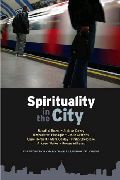Andrew walker (Editor) (SPCK 2005)

In this as so many areas, the education of the spirit is inseparably bound to highly practical challenges. If - as St Frances de Sales is supposed to have said - spiritual direction begins when people are helped to walk more slowly, talk more slowly and eat more slowly, then the life of the spirit in the city will entail asking about the size of rooms in public buildings, the flow of traffic on the streets, the levels of atmospheric pollution, the maintenance of parks, galleries and libraries, the space available for children in public - and countless other matters where decisions are regularly taken as though none of these could possibly be an issue. (Rowan Williams in Spirituality in the city, p24)
In recent times studies on space and place have seen an integration of the discussion of cities which usually focuses on planning, architecture, and economics, to incorporate the need to address the philosophical, theological, and spiritual aspects of cities. Albeit that this set of essays reflects much upon cities in Britain, this is still a very interesting little volume to read and reflect upon the every expanding city-scapes in New Zealand and the implications for faith. This book was specially commissioned by the London Centre for Spirituality and invites nine writers to help engage us with the nature of ‘spirituality’ and the urban environment of the city.
Each essay provides a different facet to spirituality in the city and offer more than a ‘sentimental’ celebration of the city. Rather, these essays are a serious attempt to understand ‘urban spirituality’ and a politic, if you like, of the built environment where insights of the work of God are discerned or made visible. So Mark Oakley writes of ‘Reclaiming Faith’ exploring the ‘intimations of the sacred –rumours of God’ (7,8) that shape faith in the city. Hence, each notes in their own way the ways in which ‘Urban life,… is at once dangerous and creative…’(R. Williams,17).
I especially appreciated essays from:
Rowan Williams, ‘Urbanisation, the Christian Church and the human Project’. Williams seeks to offer a ‘rough sketch’ of the themes and concerns that might inform an ‘urban spirituality’ with the role of the church needing some careful thought. Reflect upon the challenges he notes the use and organization of time, the question of ‘character’, life lived under the ‘sign of anonymous exchange’.
He tells us that:
We need to rescue spirituality from some of the ways in which it has been domesticated,. …. It becomes only a code for techniques of making people feel a bit better about themselves… where the Spirit makes people ‘uncomfortable about themselves and their environment, critical and creative, open to things being different. (24)
Williams wants a Church to know it has something distinct from the surrounding culture and yet has something distinct to offer society that is more humanizing.
Philip Sheldrake, ‘Cities and Human Community’; considering a theology of place, in particular aiming to hold together urbs (the physical place, buildings, etc) and civitas (people and their life together). HE offers a ‘perspective’ that considers the crisis of place engaging with writers such as Augustine, Sennet, and Augé. In regard to De Certeau he takes up the practice of the city and ‘resistance’ to systems that leave no room for otherness. In conclusion he notes some spiritual issues especially the city as a place of reconciliation.
Bernadette Flanagan, ‘Urban Spirituality, One size does not fit all’, provides an excellent overview of six models of contextual spirituality, based upon Stephen Bevans snapshots of the ways Christians go about exploring the presence of God in different contexts they find themselves in. Flanagan provides helpful insights to each model with examples. This is a very concise, yet provocative essay with wide theological and social awareness beyond ‘new ways of being church’.
Andrew Davey, ‘The Spirituality of everyday life’. HE asks what is so different about prayer/spirituality in the city? How does the urban context affect the way we pray; and vice versa? What strategies and practices might we adopt?
Davey notes ways in which our ‘Location is vital. The places where we live, work, worship and encounter others are an essential part of the formation of our spirituality and theology.’(106)While the context(s) may not be very conducive to spirituality he does admit that ‘Cities are places of possibility and encounter’ (108) in which congregations can create spaces.
Andrew Walker, ‘Urban Possibilities for daydreaming’. Seeks to take the prayer of Examen and explore the dynamics of this as a suitable and apt form of prayer to the demands and pressures of urban life. This essay is well worth consideration as it is easily applicable to adapt to any urban context and its challenge for reading the cityscape environment, but in relationship to God.
There are some repeated themes throughout and some essays will strike you more than others. While each writer is aware of the dangerous, more negative side of the city, on the whole each is hopeful of the city. I wonder about the marginal voices and what they might say about spirituality in the city and whether they might take us to other depths not greatly expressed in this work. Furthermore, this volume may have benefited from an attempt to draw out the common themes, and identify the agenda more clearly as a way to indicate ways forward. However, this is a worthy collection.